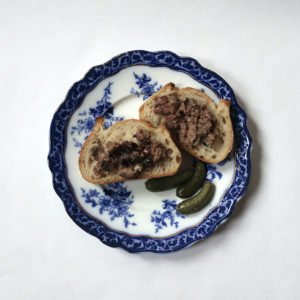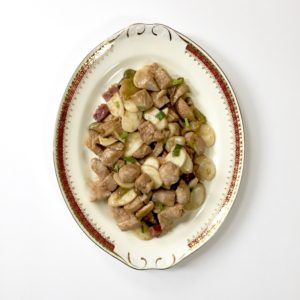Yield: two servings. Easily doubled to serve 4.
This recipe calls for searing pork chops in an oven safe pan atop the stove, then finishing the chops in a 375F/190C oven. The pan is returned to the burner, to finish the sauce.
It’s very easy to forget the pan is burning hot and grab the handle. Believe me, grabbing a blazing hot pan handle barehanded is not pleasant.
See notes, below, for discussion of ingredients and recipe variations.
As noted above, you will need an ovenproof saute pan to make pork chops with mustard sauce. You’ll also need a plate or platter and either a wooden spoon or metal spatula.
Bring the pork chops to room temperature. Lightly salt and pepper them.
Preheat the oven to 375F/190C.
Use an oven-safe saute pan that will hold both chops easily. Pour in the olive oil, heating it to medium. Add the butter. Turn heat to medium high.
Sear the pork on both sides, 3-4 minutes. Chops are ready to flip when they easily release from the pan bottom.
Once the chops are seared, put the pan in the oven for about eight minutes. Depending on your oven and how fatty (or not) the pork is, you may need more or (likely) less time. Take care not to overcook the pork, remembering it will continue cooking out of the oven.
Remove the pork at the six minute mark and check for doneness. Not sure? Make a small cut. If the meat is just slightly pink–not bloody–it’s done. Now, place an oven mitt on the pan handle and leave it there. I grabbed a 375F panhandle once, and once was enough. You don’t want to, especially just before Thanksgiving. It’s the last damned thing you need.
Remove the pork chops to the plate or platter. Tent them with foil.
Turn to your screaming hot pan with it’s cute little oven mitt hat. Turn the burner back on to medium heat. Now tip the shallot and garlic into the pan, or whatever alliums you’re using. Don’t feel bad if, like me, you mixed your onion and garlic up with your cornichons. I’ve made this dish dozens of times, and you’d think I’d remember by now to keep them separated, but no, I was cooking on American election day, meaning I was even more of a distracted mess than usual.
Cook the onion for about a minute, then add the flour and the wine. Turn up the heat a bit, take up your implement of choice and begin scraping madly, loosening all that good stuff whilst saving you from washing up.
After about 90 seconds of mad scraping, add the broth. Crank the heat up more, so the broth comes to a boil and begins reducing. You want it down by half. If you aren’t sure what that looks like, use a pan rivet as a rough guideline. Nobody is coming around with a tape measure.
If you’re nervous about breaking the sauce, you can pull the pan off heat for the next step, but I’m lazy. I just turn the heat down to the lowest tick, then add the mustard and cornichons.
Turn to your platter of chops, which will have oozed some nice juices. Add these to your sauce. Stir. Taste for salt; it shouldn’t need much, if any.
Bourdain suggests serving the pork chops with a parsley sprig, which is a nice touch if you have one. I did not.
I served pork chops with mustard sauce with spinach and rice. The bones were saved for broth.
Leftovers, should you have any, may be refrigerated in a covered container for three days.
Pork with mustard sauce may be frozen up to three months. The pork will be fine. The sauce will suffer a bit; the minced cornichons will become soggy. But you can freeze it.
As noted in the post, if pork is off the menu due to cost or dietary reasons, please do consider making the mustard sauce, which would be marvelous served atop rice or baked potatoes. It would also work with chicken.
Notes:
I’ve substituted capers for cornichons, and olives would work in a pinch. So would anchovies. I’ve also made pork with mustard sauce without any piquant element at all, and it was still good.
The allium element is flexible. Small boiler style onions are best–the kind that are hell to peel–but shallots and scallions also work.
As discussed in the post, the original recipe calls for Wondra flour, which I don’t keep in the house. Mixing cornstarch and flour is a reasonable approximation.
Vermouth and Madeira work if you don’t have white wine.
The original recipe calls for 2 tablespoons mustard. As I used less pork and very strongly flavored mustards, I cut amounts, lest the mustard take over. Season to taste.

 The recipe also calls for white wine, which of course I was out of. I used Madeira instead, an expensive yet successful substitute.
The recipe also calls for white wine, which of course I was out of. I used Madeira instead, an expensive yet successful substitute.












